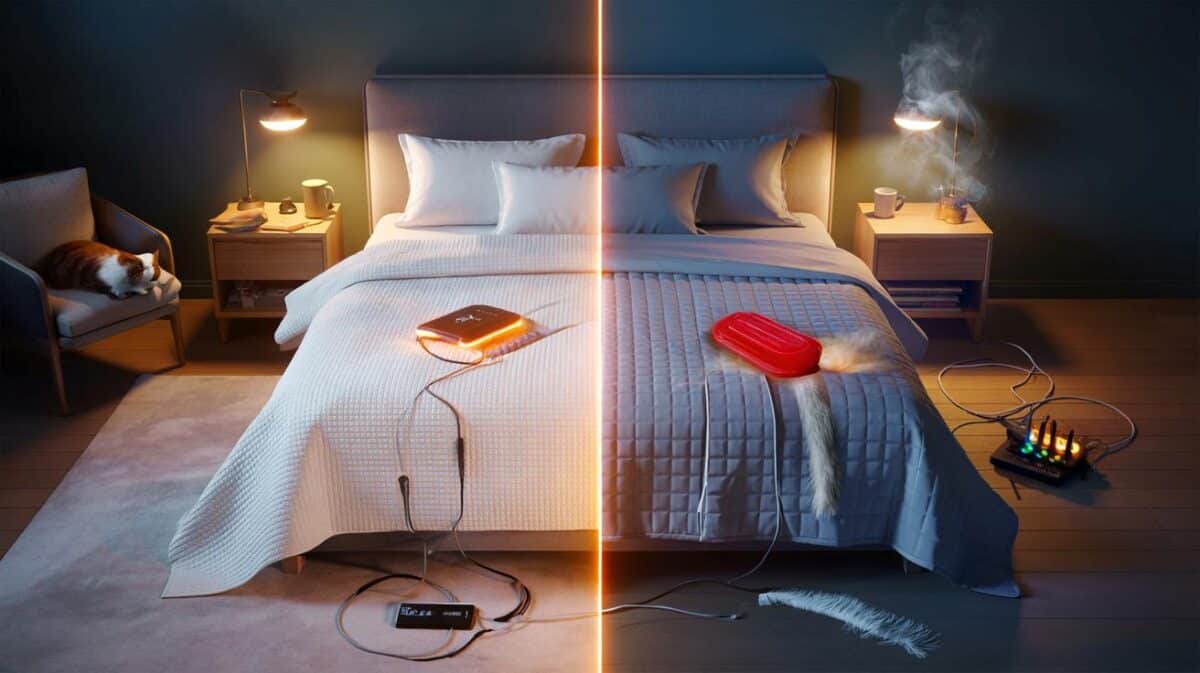Steam curls off a mug on the kitchen counter while a draught snakes under the door. We’ve all had that moment when the bill lands and your stomach tightens before you even open it. Somewhere between the hallway thermostat and the hot water tank, money is escaping as heat your home never needed. On paper it’s a tiny setting tucked behind a radiator icon, something you twist once and forget. In real life, it’s a slow leak from your bank account every time the heating clicks on. A small mistake. A big cost. And almost nobody talks about it.
The costly mistake hiding on your boiler
The biggest heating mistake in Britain isn’t a fancy gadget gone wrong. It’s a number on your boiler screen: the flow temperature for your radiators set sky-high, often 70–80°C, so your condensing boiler barely condenses at all. **The biggest heating mistake in Britain is hiding behind a tiny radiator icon.** You feel toasty for a bit, then the system cycles on and off, burning gas hard and wasting it. The room gets hot fast, then cools, then hot again, while your boiler misses the sweet spot it was designed for.
When I visited a semi in Manchester last January, the homeowner, Leila, showed me her bills and her boiler. Radiator flow was at 78°C from the day it was installed; nobody had mentioned it since. She nudged it down to 60°C, waited, and tracked a month of usage. The house felt the same, the radiators less scalding, and her gas use fell by a chunk—about 9% compared with the same cold snap the year before. Trials by UK energy groups have found similar cuts in gas use, often between 6% and 12%, which can mean £100–£300 a year depending on tariff and house size.
Here’s why. A modern “condensing” boiler saves money by pulling extra heat from water vapour in the flue. To do that, the water returning to the boiler needs to be cool enough—typically below about 55°C. Run the flow too hot and the return stays warm, so the boiler can’t condense much. You still get warm rooms, just with more gas burned per degree. Lowering the flow temperature keeps radiators warm for longer, gentler cycles, pushes the boiler into its efficient zone, and smooths the peaks and troughs of heat. *This is not about shivering in a jumper.* It’s about making the machine do the job it was built to do.
How to stop it in ten minutes
Start at the boiler, not the wall thermostat. Find the control marked with a tiny radiator symbol and set the central heating flow temperature to around 60°C. If you have a hot water cylinder, leave the hot water setting at 60°C for hygiene, as that’s needed to protect against bacteria. Combi owners: this tweak won’t change your tap temperature, just the radiator circuit. Then give the system a few days. Rooms will warm more steadily. If one stubborn room lags, bump the flow up a notch to 62–65°C, or balance your radiators so heat isn’t hogged by the closest loop.
While you’re there, bleed radiators that gurgle or have cold tops. Air kills performance. Check thermostat schedules: heat for the hours you live, not for the hours you dream. And skip the “blast it to 25°C and it’ll heat faster” myth—radiators don’t speed up because you shout at the dial. Let’s be honest: nobody does that every day. Most of us set a number once and forget, even if the house is empty for hours. A little attention once a season pays back all winter.
Small tweaks add up. A smart stat or weather-compensation control lets the boiler ease off when the outside air is milder, and a simple TRV in the spare room stops you heating a museum. **It takes ten minutes, a kettle’s patience, and zero money.**
“Set the radiator flow to about 60°C, leave hot water at 60°C for hygiene, and let the thermostat do the rest,” says Mark, a Gas Safe engineer in Leeds. “If one room won’t reach 18–20°C after an hour, balance your radiators or nudge the flow up a touch.”
- Bleed and balance radiators to fix hot–cold imbalances.
- Shut doors, use draught excluders, and close curtains at dusk.
- Use TRVs to tame guest rooms and hallways.
- Try a 19–20°C target for living spaces; lower at night.
- Look for a “radiator” icon on the boiler and set it near 60°C.
- Keep cylinder hot water at 60°C, not lower, for safety.
The bigger picture we’re missing
At street level, the UK’s heating story is terraced houses, sash windows, and boilers working too hard. One dial, rarely explained, makes the difference between a cosy evening and a creeping bill. **Turning your boiler’s flow temperature down to around 60°C can trim 6–12% off gas use in a typical home.** Not glamorous. Not a new gadget. Just the system you already own, tuned instead of thrashed.
There’s a whisper network of fixes that neighbours pass on: door seals, chimney balloons, a rug on a draughty floorboard, a timer that matches the school run. The boiler dial belongs on that list. It changes the shape of your heating day—longer, quieter cycles, less yo-yoing, fewer angry blasts. The feeling this creates is subtle, like a room that just stays happy without you fussing over it. And it sticks.
I keep thinking about the kid’s drawing on Leila’s fridge: a red house with yellow windows and a huge sun. That’s how heat should feel—gentle, even, unremarkable. No drama, no guilt. Share this with the friend who swears their house “just eats gas.” Share it with your dad who still turns the stat to 25°C “to get it going.” A small twist of a dial, a breath of patience, and a winter that costs less—not just in pounds, but in worry.
| Key points | Detail | Reader Interest |
|---|---|---|
| Lower boiler flow temp | Set radiator flow to ~60°C so condensing boilers actually condense | Cut gas use by 6–12%, saving £100–£300/year |
| Tune the system | Bleed and balance radiators, use TRVs, match schedules to real life | Warmer rooms, fewer cold spots, less boiler cycling |
| Keep hot water safe | Leave cylinder hot water at 60°C; the change is for radiators only | Confidence to save without risking hygiene |
FAQ :
- What is boiler flow temperature?It’s the temperature of water your boiler sends to the radiators. Lowering it helps the boiler recover more heat and burn less gas.
- Will my house feel colder if I drop it to 60°C?Rooms may warm a bit more slowly, then feel steadier. If one space lags, nudge the flow slightly or balance the system.
- Does this apply to combi and system boilers?Yes for the radiator circuit. For systems with a hot water cylinder, keep hot water at 60°C for safety.
- What if I have a heat pump?Heat pumps love low flow temperatures. Aim even lower, often 35–50°C with good radiators or underfloor heating.
- Do I need a smart thermostat?Not essential. Helpful features like load or weather compensation can add savings, but the biggest win is that 60°C radiator setting.








